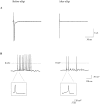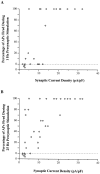Nicotinic acetylcholine receptors containing alpha7 subunits are required for reliable synaptic transmission in situ
- PMID: 10234002
- PMCID: PMC6782692
- DOI: 10.1523/JNEUROSCI.19-10-03701.1999
Nicotinic acetylcholine receptors containing alpha7 subunits are required for reliable synaptic transmission in situ
Abstract
Nicotinic acetylcholine receptors containing alpha7 subunits are widely expressed in the nervous system. The receptors are cation-selective, relatively permeable to calcium, and avid binders of alpha-bungarotoxin. Although the receptors can act both pre- and postsynaptically, their physiological significance is unclear. Using whole-cell patch-clamp analysis of chick ciliary ganglion neurons in situ, we show that the receptors are required for reliable synaptic transmission early in development. Stimulation of the presynaptic nerve root elicited a biphasic synaptic current, including a large rapidly decaying component generated by alpha7-containing receptors. Selective blockade of alpha7-containing receptors by perfusing the ganglion with alpha-bungarotoxin induced failures in synaptic transmission. One-half of the ciliary neurons that were tested failed when stimulated synaptically at 1 Hz, and two-thirds failed at 25 Hz. Failing cells missed, on average, 80% of the trials during a test train of stimuli. The ability to fire synaptically evoked action potentials after toxin treatment was correlated positively with the amplitude of the remaining synaptic current, suggesting that alpha7-containing receptors were needed to augment synaptic responses. Consistent with patch-clamp analysis, toxin blockade reduced the amplitude of the synaptically evoked compound action potential in the postganglionic nerve; it also desynchronized the firing of the remaining units. Methyllycaconitine, another antagonist of alpha7-containing receptors, mimicked alpha-bungarotoxin blockade. Toxin blockade had less impact on transmission in ganglia at the end of embryogenesis. The ability of the receptors to synchronize and sustain population firing, together with their ability to deliver calcium, may influence early developmental events such as target innervation and neuronal survival.
Figures




Similar articles
-
Mammalian nicotinic receptors with alpha7 subunits that slowly desensitize and rapidly recover from alpha-bungarotoxin blockade.J Neurosci. 1998 Dec 15;18(24):10335-44. doi: 10.1523/JNEUROSCI.18-24-10335.1998. J Neurosci. 1998. PMID: 9852571 Free PMC article.
-
Synaptically driven calcium transients via nicotinic receptors on somatic spines.J Neurosci. 2001 Feb 1;21(3):771-81. doi: 10.1523/JNEUROSCI.21-03-00771.2001. J Neurosci. 2001. PMID: 11157063 Free PMC article.
-
Synaptic potentials mediated via alpha-bungarotoxin-sensitive nicotinic acetylcholine receptors in rat hippocampal interneurons.J Neurosci. 1998 Oct 15;18(20):8228-35. doi: 10.1523/JNEUROSCI.18-20-08228.1998. J Neurosci. 1998. PMID: 9763468 Free PMC article.
-
Role of endogenous nicotinic signaling in guiding neuronal development.Biochem Pharmacol. 2007 Oct 15;74(8):1112-9. doi: 10.1016/j.bcp.2007.05.022. Epub 2007 Jun 2. Biochem Pharmacol. 2007. PMID: 17603025 Free PMC article. Review.
-
Nicotinic acetylcholine receptor: structure, function and main immunogenic region.Adv Neuroimmunol. 1994;4(4):339-54. doi: 10.1016/0960-5428(94)00032-j. Adv Neuroimmunol. 1994. PMID: 7719615 Review. No abstract available.
Cited by
-
Clustering of nicotinic acetylcholine receptors: from the neuromuscular junction to interneuronal synapses.Mol Neurobiol. 2002 Feb;25(1):79-112. doi: 10.1385/MN:25:1:079. Mol Neurobiol. 2002. PMID: 11890459 Review.
-
Synaptic Components, Function and Modulation Characterized by GCaMP6f Ca2+ Imaging in Mouse Cholinergic Myenteric Ganglion Neurons.Front Physiol. 2021 Aug 2;12:652714. doi: 10.3389/fphys.2021.652714. eCollection 2021. Front Physiol. 2021. PMID: 34408655 Free PMC article.
-
The single-channel properties of human acetylcholine alpha 7 receptors are altered by fusing alpha 7 to the green fluorescent protein.Proc Natl Acad Sci U S A. 2002 Mar 19;99(6):3956-61. doi: 10.1073/pnas.052699599. Epub 2002 Mar 12. Proc Natl Acad Sci U S A. 2002. PMID: 11891309 Free PMC article.
-
Pharmacological characterization of native α7 nicotinic ACh receptors and their contribution to depolarization-elicited exocytosis in human chromaffin cells.Br J Pharmacol. 2012 Feb;165(4):908-21. doi: 10.1111/j.1476-5381.2011.01596.x. Br J Pharmacol. 2012. PMID: 21790533 Free PMC article.
-
R-(+) and S-(-) isomers of cotinine augment cholinergic responses in vitro and in vivo.J Pharmacol Exp Ther. 2015 Feb;352(2):405-18. doi: 10.1124/jpet.114.219881. Epub 2014 Dec 12. J Pharmacol Exp Ther. 2015. PMID: 25503389 Free PMC article.
References
-
- Alkondon M, Pereira EF, Wonnacott S, Albuquerque EX. Blockade of nicotinic currents in hippocampal neurons defines methyllycaconitine as a potent and specific receptor antagonist. Mol Pharmacol. 1992;41:802–808. - PubMed
-
- Anand R, Peng X, Lindstrom J. Homomeric and native α7 acetylcholine receptors exhibit remarkably similar but non-identical pharmacological properties, suggesting that the native receptor is a heteromeric protein complex. FEBS Lett. 1993;327:241–246. - PubMed
-
- Catsicas M, Bonness V, Becker D, Mobbs P. Spontaneous Ca2+ transients and their transmission in the developing chick retina. Curr Biol. 1998;8:283–286. - PubMed
-
- Chen D, Patrick JW. The α-bungarotoxin-binding nicotinic acetylcholine receptor from rat brain contains only the α7 subunit. J Biol Chem. 1997;272:24024–24029. - PubMed
Publication types
MeSH terms
Substances
Grants and funding
LinkOut - more resources
Full Text Sources
